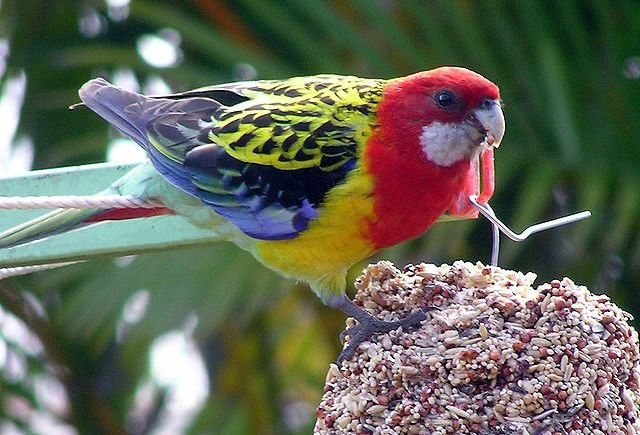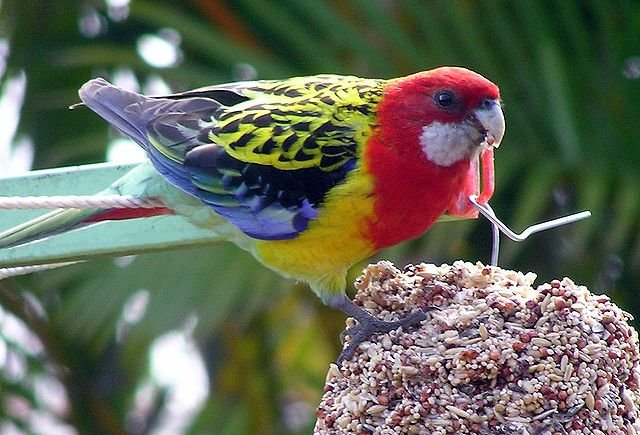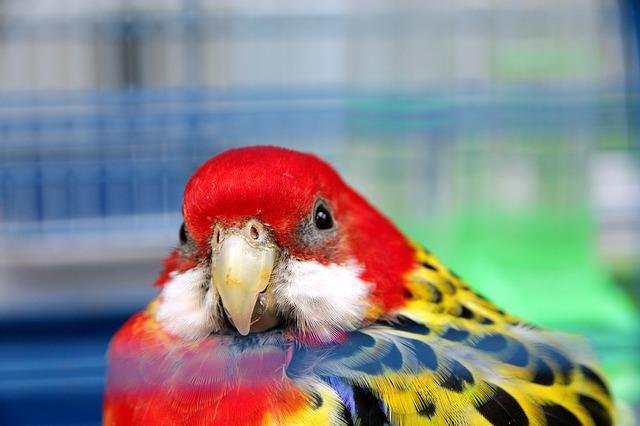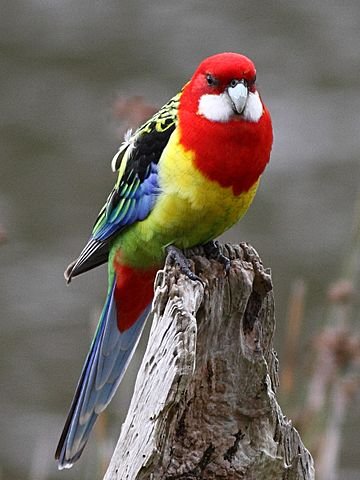Parrots are the most favored companion-pet across the globe and a whopping one-sixth of the whole species belong to the Australian continent. So, when it comes to choosing a great companion, everyone searches for the most famous or beautiful Australian parrots. And the list is never complete without the mention of Eastern Rosellas.
Eastern Rosellas are medium-sized vividly colored parrots that are an extremely common sighting in Australia. Even these birds aren’t afraid of human presence since they come quite close and let the people feed them. Where living in the wild gives all of them an opportunity to pick and choose what they like. But living as pets, they are totally dependent on their owners to care for their well-being. And diet ranks at the top if one has to keep his pet healthy and hearty.
Eastern Rosella Diet in the Wild
Habitat decides the diet of any being. And while living in the wilderness, Eastern Rosellas choose to live in the open savannahs, bushlands, or farmlands. When living close to city establishment, they frequent the parks, backyards, or golf courses. The reason being all these places have enough of their favorite food supplies. They simply love to raid the ground of all these places.
Seeds
Seeds are Eastern Rosella’s favorite food and if they are from Eucalyptus, they are the happiest beings. Easterns love to gorge on the seeds of this tree and a flock of them can easily be spotted in regions where Eucalyptus are in abundance. Instead of feeding on the trees itself, these birds prefer to feed on the seeds fallen on the ground beneath and are thereby famous as ground feeders. Apart from the forest areas, they also love to feed on the seeds from the pastures, lawns, or such other cleared areas.
Fruits
Fruits are Eastern’s other favorite in the wild. They love eating blueberries, cherries, berries, etc. in the wild. They also love feeding on the nectar of the flowers of the fruits. One might spot them in the orchards on the outskirts of the city.
Insects
Insects are a staple for Eastern Rosellas in the wild and they simply love having them live. Worms like mealworm and insect larvae are their favorite. It also fulfills their daily protein dietary needs.
Eastern Rosella Diet in Captivity
Living in captivity, Eastern Rosellas are completely dependent on their owners for a healthy and balanced diet. And if they are fed that way, they live longer than in the wild.
Seeds
Since seeds are Easterns favorite, serving them a portion of these in captivity keeps the bird happy along with being healthy. Though Eucalyptus are their preference in the wilderness, they love gorging on oats, sunflower, quinoa, safflower, barley, et al at home. To prevent boredom from kicking in, serve them a mix of any two or three of them and keep rotating the alternatives.

Seeds are high in fat and can cause obesity if fed in excess. So, moderation is the key. Serving a spoonful or two every day is just enough to maintain an optimum nutrient profile. To reduce the fat content further, serve them as sprouts. Or soak them for sometime before serving.
Pellets
Pellets are an indispensable part of any pet bird’s daily diet forming the majority of his daily food bowl. The reason is that they have everything that a bird’s diet might be lacking in. There are many good quality brands of pellets that one can get his hands on online or in a pet store.
Check what we have to offer in the Amazon store, this is our affiliate link and we get a commission for the purchase. Thanks for keeping the site running 🙂
Fresh Fruits
Eastern’s love for fruits stays the same even in captivity. Feed them a dose of fresh fruits and they will be more than happy. Some of their favorite fruits that are also easily available across the globe are apples, berries, bananas, papaya, peaches, cranberries, kiwi, mango, oranges, grapes, pears, etc.
Serve these fruits in bite-sized pieces that are easy to chew or serve them pureed. Or one can find another alternative way that his bird likes the fruit platter.
Vegetables
Just like fruits, vegetables are essential to complete the nutrient profile in Eastern’s diet. Feed him the dark-colored vegetables for his daily Vitamin A, K needs. It includes vegetables like sweet potatoes, carrots, winter squash, etc.
The green vegetables like spinach and broccoli are a must for the bird’s calcium needs. Additionally, collard greens, corn, sweet peas, kale, beet greens, cucumber, cauliflower, sweet bell peppers, etc. can also be served for keeping the bird interested in a tasty and colorful yet healthy plate.
Nuts
When in the wild, Easterns love having nuts. And serving them in captivity isn’t a bad idea either as they are rich in fatty acids that support healthy brain functioning. Walnuts, almonds, cashews, macadamia nuts, hazelnuts, pine nuts, pecans, etc. serve as a great option.
Insects
Easterns have a natural liking towards eating insects and if served in captivity too, it becomes their favorite meal for obvious reasons. Many owners prefer keeping their birds feel-at-home by replicating their feeding habits as in the wild along with other such things. To find live insects, the backyard is the best place. If that is not the possibility, raid any public park to find them in plenty.
Freshwater
One must-have that even goes unsaid is feeding freshwater to the bird. To keep the bird’s body hydrated, a drinkable freshwater is necessary at all times. One can place a bowl inside the bird’s cage and ensure that it is refilled again and again. It must never run out of supply especially in summers.
An important thing is to ensure that water must be of drinkable quality and hence must be free from all the chemicals and trace elements. Hence, filtered or boiled water must be used to avoid any water-related diseases.
Cuttlebone
Cuttlebone is a must for Easterns like any other pet parrot species. Chewing on it helps in restoring the calcium reserves in the bird’s body, especially females as they are prone to calcium deficiency during the egg-laying process.
What not to Feed Eastern Rosella
Just as some foods are completely off-the-list for humans, Eastern Rosellas shouldn’t be fed something that he has not been made to digest naturally. And for some foods, the quantity also matters. The lesser they are fed, the better.
Toxic Drinks
There are many drinks that must not be fed to these birds as they can prove toxic to them. And the most notable one among that list is alcohol. Any drink that contains alcohol, pure or diluted, must never be served to Easterns.
The next kind of drink that can prove harmful for the bird is every drink that has caffeine. Coffee, tea, energy drinks, or carbonated drinks are all harmful to the bird’s system as it is a psychoactive drug.
Toxic Foods
There are many foods that are toxic to Eastern Rosellas and must not be fed to the bird. Pitted fruits like avocado or plums should not be fed to Easterns as they contain a substance that is cyanide-like. Also, fruits that have oxalic acid like rhubarb are also poisonous for the bird. And lastly, mushrooms and chocolate must be off the Eastern’s food list.
Excess Dairy
Dairy needs a very strong metabolism to get digested and with that small body, Eastern’s lack it. Feeding the bird a small cheese cube once in a while is totally okay but feeding him, say milk or yogurt, daily in large quantities will make the bird fall sick rather sooner.
Useful Tips for Best Diet for Eastern Rosella
- Seed mix must be preferably prepared at home as the market-made mix as it is high in added preservatives and inorganic additives.
- Serve all the fruits freshly cut. And discard the foods if kept uneaten by the bird for more than a day. The chances are very high that it has grown bacteria.
- Remove the seeds and pits of all the fruits before feeding them to the bird. The bird might choke on it accidentally.
- Serve all the nuts unsalted. Also, do not overdo in serving them as they are high in fats and hence, can make the bird obese. Serve half an almond or a pine nut, preferably as a reward to the bird.
- Wash all the dishes, namely fruits, vegetables, and water, for a great hygienic diet.
- Always keep a backup food and water bowls in the bird’s cage, especially in summers as the bird’s metabolism is high in hot weather.
Summing Up
Adopting a pet Eastern Rosella is becoming more common these days due to a spike in their popularity courtesy his colorful personality. Though native to the Australian continent, they can be easily spotted in mushy woodlands and fruity backyards across the globe. When kept as a pet, they are not that high maintenance as other pets like cats or dogs, in dietary needs context. Having a small serving of their favorite fruits and vegetables keeps the bird healthy and hearty. And it is a cherry on the cake if they get an occasional dose of their favorite nuts or insects every now and then.
Read more about Eastern Rosella Color And Mutations:
https://parrotquaker.com/eastern-rosella-color-and-mutations/




